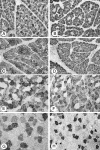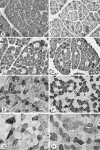Myosin heavy chain isoform transitions in canine skeletal muscles during postnatal growth
- PMID: 16879596
- PMCID: PMC2100321
- DOI: 10.1111/j.1469-7580.2006.00599.x
Myosin heavy chain isoform transitions in canine skeletal muscles during postnatal growth
Abstract
To gain a better understanding of the normal characteristics of developing canine muscles, myosin heavy chain (MHC) isoform expression was analysed in the axial and limb skeletal muscles of 18 young dogs whose ages ranged from the late prenatal stage to 6 months. We compared the results of immunohistochemistry using ten monoclonal antibodies, specific to different MHC isoforms, and enzyme-histochemical reactions, which demonstrate the activity of myofibrillar ATPase, succinate dehydrogenase (SDH) and alpha-glycerophosphate dehydrogenase (alpha-GPDH). In the skeletal muscles of fetuses and neonatal dogs the developmental isoforms MHC-emb and MHC-neo were prevalent. In all muscles the primary fibres, located centrally in each muscle fascicle, strongly expressed the slow isoform MHC-I. The adult fast isoform MHC-IIa was first noted in some of the secondary fibres on fetal day 55. During the first 10 days after birth, the expression of MHC-emb declined, as did that of MHC-neo during the second and third weeks. Correspondingly, the expression of MHC-IIa, and later, of MHC-I increased in the secondary fibres. Between the sixth week and second month the expression of MHC-IIx became prominent. The slow rhomboideus muscle exhibited an early expression of the slow isoform in the secondary fibres. Our results indicate that the timing of muscle maturation depends on its activity immediately following birth. The fastest developing muscle was the diaphragm, followed by the fast muscles. A pronounced changeover from developmental to adult isoforms was noted at 4-6 weeks of age, which coincides with the increased physical activity of puppies.
Figures







Similar articles
-
New insights into skeletal muscle fibre types in the dog with particular focus towards hybrid myosin phenotypes.Cell Tissue Res. 2006 Feb;323(2):283-303. doi: 10.1007/s00441-005-0057-4. Epub 2005 Sep 15. Cell Tissue Res. 2006. PMID: 16163488
-
Characterization of human oro-facial and masticatory muscles with respect to fibre types, myosins and capillaries. Morphological, enzyme-histochemical, immuno-histochemical and biochemical investigations.Swed Dent J Suppl. 1994;98:1-55. Swed Dent J Suppl. 1994. PMID: 7801228
-
Identification of myosin heavy chain I, IIa and IIx in canine skeletal muscles by an electrophoretic and immunoblotting study.Cells Tissues Organs. 2005;180(2):106-16. doi: 10.1159/000086751. Cells Tissues Organs. 2005. PMID: 16113539
-
Myosin isoforms in mammalian skeletal muscle.J Appl Physiol (1985). 1994 Aug;77(2):493-501. doi: 10.1152/jappl.1994.77.2.493. J Appl Physiol (1985). 1994. PMID: 8002492 Review.
-
The impact of biochemical methods for single muscle fibre analysis.Acta Physiol Scand. 1999 Aug;166(4):261-77. doi: 10.1046/j.1365-201x.1999.00568.x. Acta Physiol Scand. 1999. PMID: 10468663 Review.
Cited by
-
Comparative oncology reveals DNMT3B as a molecular vulnerability in undifferentiated pleomorphic sarcoma.Cell Oncol (Dordr). 2022 Dec;45(6):1277-1295. doi: 10.1007/s13402-022-00717-1. Epub 2022 Oct 1. Cell Oncol (Dordr). 2022. PMID: 36181640 Free PMC article.
-
Transitional Hybrid Skeletal Muscle Fibers in Rat Soleus Development.J Histochem Cytochem. 2019 Dec;67(12):891-900. doi: 10.1369/0022155419876421. Epub 2019 Sep 11. J Histochem Cytochem. 2019. PMID: 31510854 Free PMC article.
-
The role of cremaster muscle in testicular descent in humans and animal models.Pediatr Surg Int. 2011 Dec;27(12):1255-65. doi: 10.1007/s00383-011-2983-4. Epub 2011 Oct 30. Pediatr Surg Int. 2011. PMID: 22038274 Review.
References
-
- Acevedo LM, Rivero JL. New insights into skeletal muscle fibre types in the dog with particular focus towards hybrid myosin phenotypes. Cell Tissue Res. 2005;323:283–303. - PubMed
-
- d’Albis A, Couteaux R, Janmot C, Mira JC. Myosin isoform transitions in regeneration of fast and slow muscles during postnatal development of the rat. Dev Biol. 1989a;135:320–325. - PubMed
-
- d’Albis A, Couteaux R, Janmot C, Roulet A. Specific programs of myosin expression in the postnatal development of rat muscles. Eur J Biochem. 1989b;183:583–590. - PubMed
-
- d’Albis A, Janmot C, Couteaux R. Species- and muscle type-dependence of perinatal isomyosin transitions. Int J Dev Biol. 1991;35:53–56. - PubMed
-
- Baldwin KM, Haddad F. Effects of different activity and inactivity paradigms on myosin heavy chain gene expression in striated muscle. J Appl Physiol. 2001;90:345–357. - PubMed
Publication types
MeSH terms
Substances
LinkOut - more resources
Full Text Sources
Research Materials

